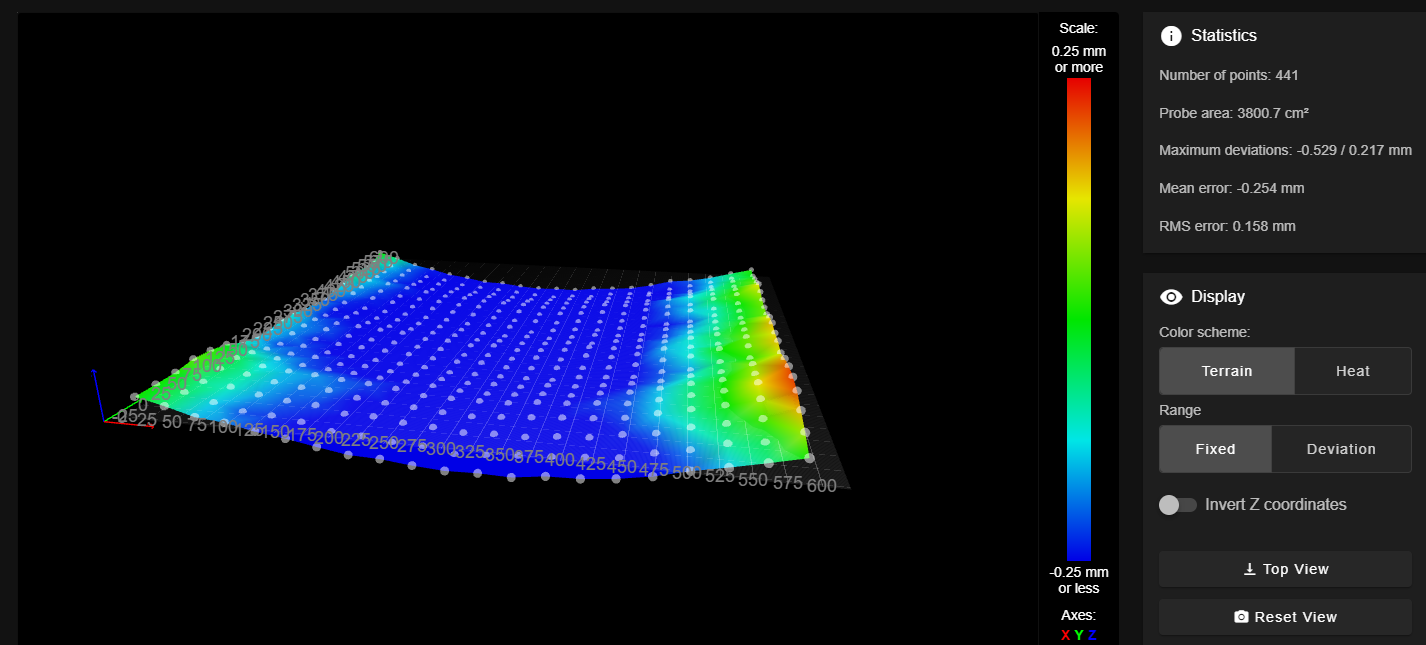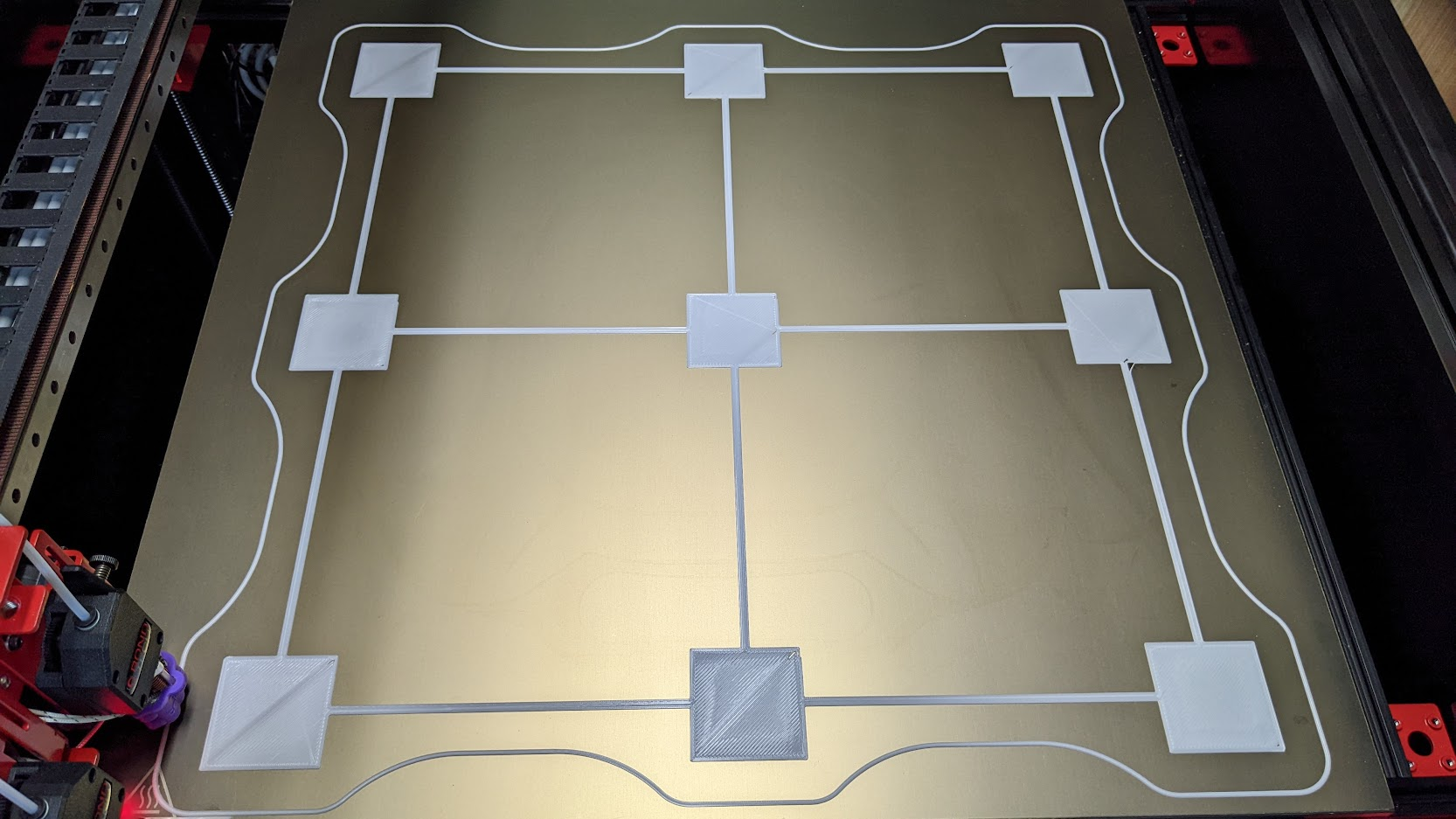Query Mesh Bed Compensation Status
-
Always glad to help when I can - or at the very least not make things much worse.

The areas between the points are where you would expect to find problems.
As to understanding the leveling issues watch the video. It should make it all clear.
Are you setting the Z=0 Datum (a single G30) at the center of the bed?
The colors of your height map suggest you are not.
Does the bed have any adjustments allowing to raise/lower different places on the bed.
Assuming the gantry is nice and square to the bed it looks like the bed is sagging quite a bit.
Frederick
-
Some other fun reasons why a mesh bed may not be in line with reality:
a) skewed probe
b) gantry twistSince the heightmap is a CSV file you could for tests modify one of the points to be 10mm higher and then after loading the height map, make a move that crosses or ends at that modified point. It should move the bed 10mm lower.
I like @fcwilt s idea to probe Z at the center of the bed, but I like it even more when the Z probe is close to the center of the bed and matches one of the points in the mesh. That gives you good reference between probing Z and building the mesh.
-
Also
echo move.compensation.typereturns "none" when compensation is disabled, and "mesh" when a mesh is loaded. -
@oliof said in Query Mesh Bed Compensation Status:
I like @fcwilt s idea to probe Z at the center of the bed, but I like it even more when the Z probe is close to the center of the bed and matches one of the points in the mesh.
Absolutely the preferred approach.
I don't do it because I create a number of different height maps for different printing situations.
Frederick
-
No, my Z=0 Datum isn't in the center, it's at the nearest corner near the origin. (One of the 4 corners that's probed during the bed leveling.) And I'm going to watch the video now, because I don't understand why it makes any difference where my datum is, as long as it's in the same spot before and after height mapping...
No, no bed adjustments other than the motors.
And yes, that sag seems pretty typical for these machines, from what I've seen from others' heightmaps.
@oliof I think the probe looks fine, but I'll double-check the gantry to see if I have any twist.
So thinking about putting the z datum at the center of the bed... In my case that would be near one of the lowest points on the bed. So if I were to print something with the mesh compensation turned off, the first thing I would probably do is scrape my nozzle through the PEI surface... Wouldn't it be safest to have the datum at the highest point of the bed, so that if, somehow, mesh compensation were turned off then the failure would be to print too high?
And I'm convinced now that mesh compensation IS turned on. The z axes motors move a little as the printhead rounds the bed. I think it would be a lot worse if it weren't. It's just something that's off...
-
OK, I spent this weekend calibrating and tuning and learning RRF, and I made a lot of progress!
Turns out my problem was a twisted y-axis. It was pretty square on the front but twisted quite a bit on the back. As my probe offset in the x-axis is 24 mm, even a couple of degrees would result in a significant layer height error. Fixing this problem was the key.
But beyond that, I changed quite of the logic around the bed leveling.
My bed has the typical "Modix sag" because it is not supported with rigid-enough members. The front and rear rails are 2020 extrusion spanning ~80 cm, and that's just not stiff enough. I have 2040 on order, and I'm going to upgrade these when it arrives. It won't eliminate the sage, but should improve it significantly.
It also sags front to back, as there is no support on the sides, but my guess is that's intentional: The y-axis gantry sags, too and as a result, you can barely see it in the surface maps! I'll deal with this at a later date...
I watched the video, but it wasn't very useful for my situation. My bed is supported on the 4 corners, not just 3 points, and while I can't make the midpoints of the 4 edges coplanar, I can make the corners coplanar.
So I put my z datum at the front left corner, because this is one of the highest spots. If mesh bed compensation is turned off for some reason, the failure mode will be printing too high rather than engraving into my PEI sheet. (And I keep finding new macros that turn mesh bed compensation off!
 I think I've fixed all that, now, so I shouldn't be surprised and I'm not rehoming all the dang time!)
I think I've fixed all that, now, so I shouldn't be surprised and I'm not rehoming all the dang time!)I modified the routines so that:
- The z homing routine is at the datum location,
- The 4-corner leveling routine uses the same location for one of the corners,
- The mesh bed compensation is performed between the 4 corners used for bed leveling. and
- The probe z height compensation is performed at the same location.
As a result, the height map reads zero at the 4 corners, which includes my datum.
I've performed the height mapping with a 21 x 21 grid, and my first layer tests are looking amazing, now! Now on to fine tuning my slicer settings...
Thank you for all your help!!
And a pretty pictures:


-
That looks very good.
Any reason you could not add a frame member, running front to back, at the center of the bed, to get rid of that sag?
The flatter the bed the less work the Z axis has to do during printing, saving wear and tear.
Frederick
-
@fcwilt Thank you!
Yes, I can add frame members from front to back. There are already two members there, but they're not under the edges of the bed. (You can see one of them on the right in the image above. Just to the right of the actual bed. That's how they tell us to put it together.) My guess is that they originally were under the bed, but now they have us put them off to the side so that the bed sag compensates for the y-axis sag. (The y-axis also runs front to back.)
I've read a few posts about people stiffening up the y-axis, and if I do that, then I'll add the support members for the bed, as well.

-
@tfjield said in Query Mesh Bed Compensation Status:
...off to the side so that the bed sag compensates for the y-axis sag.
That does not strike me as a good design philosophy - create one flaw to compensate for another.

So I would be in the "fix the sag in both Y and the bed" crowd.
Good luck.
Frederick
-
@fcwilt Yup, I'm with you! It's just triage right now in the little time I have between prints!
